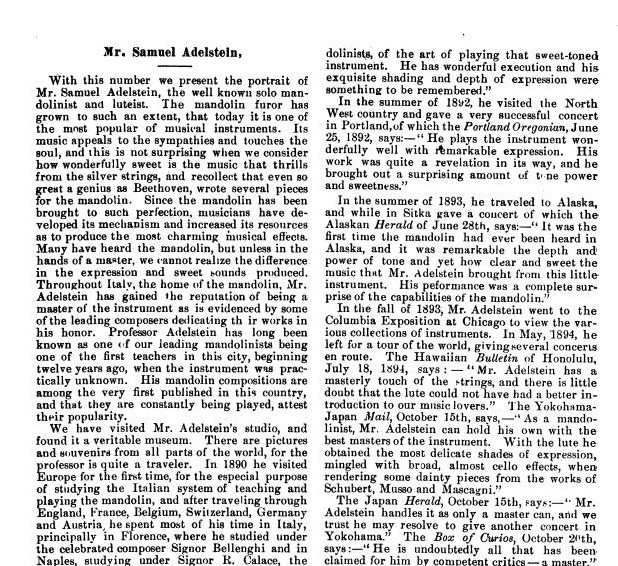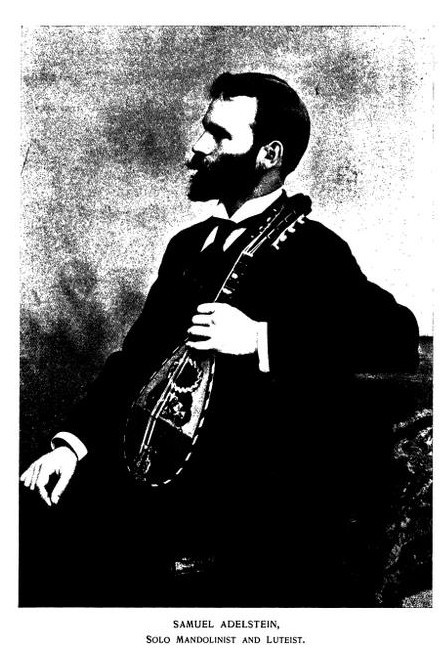| Samuel Adelstein |
| --
google Anzeige -- |
| Bitte
teilen sie diese Seite: |
 |
|
With this number we present the portrait of Mr. Samuel Adelstein, the well known solo mandolinist and luteist. The mandolin furor has grown to such an extent, that today it is one of the most popular of musical instruments. Its music appeals to the sympathies and touches the soul, and this is not surprising when we consider how wonderfully sweet is the music that thrills from the silver strings, and recollect that even so great a genius as Beethoven, wrote several pieces for the mandolin. Since the mandolin has been brought to such perfection, musicians have developed its mechanism and increased its resources as to produce the most charming musical effects. Many have heard the mandolin, but unless in the hands of a master, we cannot realize the difference in the expression and sweet bounds produced. Throughout Italy, the home of the mandolin, Mr. Adelstein has gained the reputation of being a master of the instrument as is evidenced by some of the leading composers dedicating their works in his honor. Professor Adelstein has long been known as one of our leading mandolinists being one of the first teachers in this city, beginning twelve years ago, when the instrument was practically unknown. His mandolin compositions are among the very first published in this country, and that they are constantly being played, attest their popularity. We have visited Mr. Adelstein's studio, and found it a veritable museum. There are pictures and souvenirs from all parts of the world, for the professor is quite a traveler. In 1890 he visited Europe for the first time, for the especial purpose of studying the Italian system of teaching and playing the mandolin, and after traveling through England, France, Belgium, Switzerland, Germany and Austria, he spent most of his time in Italy, principally in Florence, where he studied under the celebrated composer Signor Bellenghi and in Naples, studying under Signor R. Calace, the great luteist. During this visit, he had the distinguished privilege of being elected an honorary member of the Circolo Mandolinista Regina Margherita, of which the Queen Margherita is Royal Patroness. This Circolo is composed of seventy members, mandolins, mandolas, lutes, guitars, and harps, of which Signor Matini is director. As a souvenir of this visit and in token of their esteem, the following solos were composed and dedicated to Mr. Adelstein: Ricardi di Firenge, Notturno, for two mandolins, mandola, piano and guitar, by Ricaido Matini; T'Amo (I love you) Romanga senza parole, for two mandolins, mandola, lute, cello, flute, piano, and guitar, by Leo D' Ageni. Garratta for mandolin and piano, by Ugo Bonducci; Musica Proibita (the original score presented to Mr. Adelstein) for two mandolins, mandola, violin, cello, harp, and piano, by Graziani-Walter, and Fantasia Capriceis for lute solo, by R. Calace. While in Paris in April, 1890, he met Signor Pietrapertosa, the great soloist, who as a souvenir of friendship inscribed the "Brise de Naples," Grande Valse de Concert. Mr. Adelstein has given several mandolin musicales in this city and elsewhere. The Argonaut of September 12, 1891, says:-"Professor Adelstein's rendition was a revelation to local mandolinists, of the art of playing that sweet-toned instrument. He has wonderful execution and his exquisite shading and depth of expression were something to be remembered." In the summer of 1892, he visited the North West country and gave a very successful concert in Portland,of which the Portland Oregonian, June 25, 1892, says:-" He plays the instrument wonderfully well with remarkable expression. His work was quite a revelation in its way, and he brought out a surprising amount of tone power and sweetness." In the summer of 1893, he traveled to Alaska, and while in Sitka gave a concert of which the Alaskan Herald of June 28th, says:-" It was the first time the mandolin had ever been heard in Alaska, and it was remarkable the depth and power of tone and yet how clear and sweet the music that Mr. Adelstein brought from this little instrument. His peformance was a complete surprise of the capabilities of the mandolin." In the fall of 1893, Mr. Adelstein went to the Columbia Exposition at Chicago to view the various collections of instruments. In May, 1894, he left for a tour of the world, giving several concerts en route. The Hawaiian Bulletin of Honolulu, July 18, 1894, says:-"Mr. Adelstein has a masterly touch of the strings, and there is little doubt that the lute could not have had a better introduction to our music lovers." The Yokohama Japan Mail, October 15th, says:-"As a mandolinist, Mr. Adelstein can hold his own with the best masters of the instrument. With the lute he obtained the most delicate shades of expression, mingled with broad, almost cello effects, when rendering some dainty pieces from the works of Schubert, Musso and Mascagni." The Japan Herald, October 15th, says:-"Mr. Adelstein handles it as only a master can, and we trust he may resolve to give another concert in Yokohama." The Box of Curios, October 2Sth, says:-" He is undoubtedly all that has been claimed for him by competent critics - a master." On the eve of his departure from Japan he was invited to perform for the Royal Family, at a concert given for the benefit of the soldiers wounded in the war, by the Red Cross Society, under the patronage of the Imperial Family. Mr. Adelstein was also offered a position in the Royal Conservatory of Tokio, but his Bohemian propensities drove him on around the world. He traveled to China, visiting Hongkong, Canton and Macao, Saigon, Siam, Singapore, and Penang on the Malay Peninsula, saw the wonderful golden pagodas in Maulmein and Rangoon in Burmah, sailed across the Bay of Bengal to Calcutta, and spent several weeks traveling through India, visiting Darjuling, the northernmost town in India, on the borders of Thibet, from where the mighty Himalayas and lofty Mt. Everett can be seen. Benares, with its sacred Ganges, the holy city of the Hindoo, Lucknow, with its memories of the terrible mutiny and siege, Agra with its wondrously beautiful Taj Mahal, Delhi, with its Royal Palaces of the Great Moguls Jeylore, the most picturesque native city in India, and Bombay, the " Eye of the East," with its Parsees and their terrible Towers of Silence! He sailed from Bombay across the Arabian Sea to Aden, the hottest place in the world, up the Red Sea to the Gulf of Suez, through the Suez Canal to Ismailia, and thence by rail to Cairo. He spent some time in Cairo, visiting the mosques, museums, Pyramids, Sphinx, etc., and then took a steamer trip up the Nile to the First Cataract, visiting Luxor, Thebes, Assouan and the Island of Philae. On his return to Cairo he sailed from Alexandria to Jaffa and thence by rail to Jerusalem, where he spent two weeks visiting Bethlehem, Dead Sea, Jordan, and Jericho. He sailed from Port Said to Italy and visiting the scenes of his former visit and meeting his old friends and while in Rome studied with the great masters, Signors Conti and Branzoli. Signor Branzoli is the author of the celebrated method and as a mark of esteem composed and dedicated to Mr. Adelstein a Serenata for two mandolins, mandola, guitar and piano. In Florence Mr. Adelstein studied with Signor Munier, and Signor Bellenghi dedicated a beautiful composition, " Una Stellei," for two mandolins, mandola, lute, cello, flute, piano and guitar. Signor Gragiani-Walter presented to Mr. Adelstein, the original manuscript score of the Suite Villageoise Villereccia for two mandolins, mandola, flute, violin, cello, guitar, organ, harp, and piano. Among other compositions dedicated to Mr. Adelstein, as a souvenir of his second visit to Italy are " Dichairagione d' Amore," Melodia, and "Colombe Innamorata," Valse Brilliante, by Leo D' Ageni, " Via Lattea," Notturno Sentimentale, by Nicolo Calace and " Do, re mi fa," Moncia popolare, by Pirani. After his very pleasant stay in Italy, Mr. Adelstein sailed across the Mediterranean Sea to Gibraltar, and made a tour of Spain, visiting Granada, the Alhambra, Seville, Cordora, Madrid, returned to Gibraltar, crossed the straits to Africa, visiting Tangiers, Morocco, recrossed Gibraltar, sailed to New York, and returned to San Francisco after an absence of thirteen months. Mr. Adelstein is the possessor of a beautiful Italian lute, an instrument almost unknown in this country, and only lately revived in Italy. It has the deep, rich, resonant tones of the cello, in fact, when not seen by the listener, can hardly be distinguished from the cello. The lute and mandola have made it possible for lovers of thie instrument played tremolo, with the plectrum, to perform many of the string quartettes of the old masters. |
 |
|
Quelle: http://hdl.handle.net/2027/miun.ach3746.0003.001?urlappend=%3Bseq=4 http://hdl.handle.net/2027/miun.ach3746.0003.001?urlappend=%3Bseq=8 http://hdl.handle.net/2027/miun.ach3746.0003.001?urlappend=%3Bseq=10 Noten "Musica Proibita" von Graziani-Walter: |
>>> Zurück zum Inhalt - Back to the Contents <<< |
| Wenn
sie diese Seite
ohne Navigationsleiste angezeigt bekommen, dann klicken sie hier um die MandoIsland Homepage zu öffen: |
 |